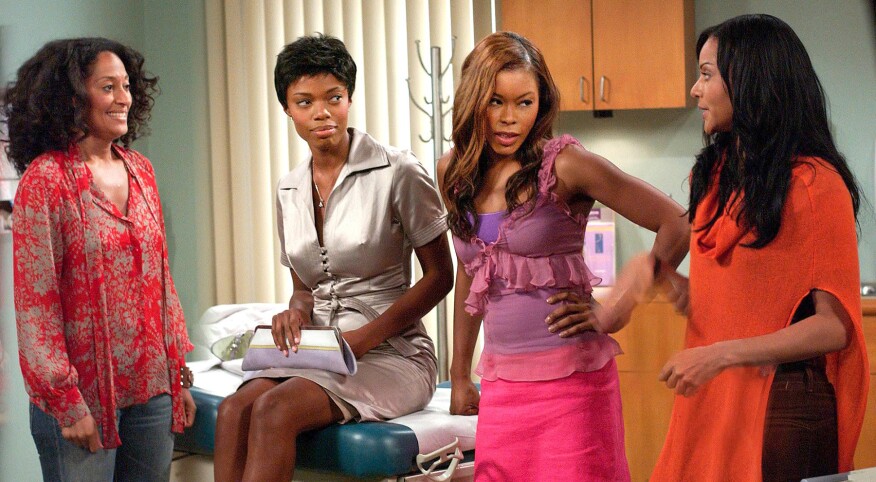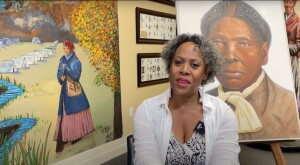I was sinking into the couch in my daughter Harmony’s first living room, feeling the uncomfortable shift in our dynamic and the unfamiliar distance between us.
My daughter and I had always been close, and up until she graduated from college, I knew everything about her — until I didn’t. She was now a single professional young woman with a place of her own and a group of girlfriends her own age. In the past, she had always wanted us to be best friends, and I had always resisted it.
I opened the Netflix app on my iPad, and my finger quickly swiped left across the show title thumbnails. Then I saw the image of Joan, Toni, Maya and Lynn in white crop tops and shorts posed beneath the word “Girlfriends.”
“OMG!” I said to Harmony. “I remember this was the show back in the day.” Harmony sat down on the couch beside me and leaned in to look at the image. “Let’s just watch the first episode,” I said pleadingly. “If you don’t like it, we’ll watch something else.”
“OK,” she said.
Then the song closed with the lyric, “my gurl-url-friends,” that faded out while all four women laughed and bumped hips with one another in the final frame. Harmony and I both laughed at how extra the opening was.
After the opening scene ended, the theme song began: “Ooooh, my girlfriends, there through thick and thin.” This played while each woman sauntered toward the camera and did her signature dance move. I sang along with the second verse and imitated with a body roll. “My girlfriends, there for any-thing.”
Toni turned to the side and pumped her hips back and forth. Then the song closed with the lyric, “my gurl-url-friends,” that faded out while all four women laughed and bumped hips with one another in the final frame. Harmony and I both laughed at how extra the opening was.
When I watched Girlfriends for the first time in 2000 on UPN, Harmony was 5 years old, Destiny’s Child was at the top of the charts, and I was 28, just one year younger than the main character, Joan Clayton. I was a mom, wife and teacher at the time, so I couldn’t relate to Joan’s life as a successful lawyer with a fashionable life and a quiet house of her own. But I tuned in weekly for Joan’s outfits, Maya’s clapbacks, and the drama and laughs Toni and Lynn brought to each episode. The show represented the diversity among Black women, and the dynamic between them was authentic and relatable.
From the very beginning, the show illustrated that friendships are complex and it’s hard to keep up with all the rules. In Episode 1, Toni breaks a girlfriend rule by dating Joan’s ex and not telling her. Lynn warns Toni, “If you do not tell her, I will.” Later in the episode, Lynn has Toni by the hair to force her to call Joan.
At Joan’s house, Maya finds out about Toni’s violation and says, “Oh, hell no!” Harmony and I laughed with the studio audience. “Black women don’t do that,” Maya says in Toni’s face.
Harmony hit the pause button.
“See, Maya is the better friend even though she is Joan’s newest friend. And I like the dynamic of them being friends. But I know you don’t,” she said, laughing a little. She knew how I am about boundaries and wanted to test if she was right.
For months, Harmony and I bridged the generation gap while watching Girlfriends on Netflix. Each new episode led to conversations about Black womanhood, communication and friendship.
“I don’t dislike that they’re friends,” I said defensively. “I just think it’s weird to be friends with your assistant because they’re not on an equal playing field.”
“Yes,” Harmony countered, “but I like that it goes against the whole hierarchy thing.”
“But Joan is Maya’s boss, and it’s weird to be in a position to tell your friend what to do or fire them,” I said.
The conversation ended there, and I recognized another difference in our generations. Mine was taught to honor hierarchies, and hers was working to dismantle them. I reflected on my statement about an equal playing field. Is this a prerequisite for friendship?
My mind flashed back to a decade earlier during a car ride back home after one of Harmony’s last days of middle school. She looked over at me from the passenger seat and said, “Mom, you’re my best friend.” I bristled. “No, I’m your mom, and I can’t be your best friend and tell you what to do,” I said with a half chuckle.
With that sentence, I placed a boundary between us and watched her chest sink a little before I turned to put my eyes on the road. Back then I thought “friend” and “mother” were mutually exclusive. And at the time, there were two decades between us.
“What did you think?” I asked as the show’s closing credits scrolled up toward the top of the screen.
“I liked the topics they covered. I liked that Joan had a house her friends could gather at.”
“Yeah, that was cool,” I said. “I don’t think I thought much about that at the time.”
I realized those in Harmony’s generation have had access to seeing more single women with careers and homes than I had in mine. My generation saw the way into a home through marriage and family.
For months, Harmony and I bridged the generation gap while watching Girlfriends on Netflix. Each new episode led to conversations about Black womanhood, communication and friendship.
I also realized something else: I had raised a young woman I would have chosen as a friend.
I began to listen more to her point of view and learned to see elements of the show differently. Little by little, I felt the gap between us close. Girlfriends acted as a meeting place as well as a bridge.
One night I looked over at 26-year-old Harmony from the couch and listened as she broke down why she loved the show so much. I realized that although the actresses in this show are now closer to my age than to hers, Harmony was much closer to these women in this moment in time.
I also realized something else: I had raised a young woman I would have chosen as a friend.
I was wrong to think that because I was Harmony’s mom I couldn’t one day become her friend. I wish I’d known to tell her that day in the car that one day, when we were both women, things would be different. Because sometimes a girlfriend gives you advice and also tells you what to do. Sometimes your newest girlfriend is a better friend that the ones you’ve known most of your life, and sometimes your best girlfriend is also your daughter.
Watching Girlfriends with my daughter allowed me to go back in time and see friendship in a new way. It wasn’t about a level playing field. Friendship was about shared interests and experiences, love, trust and respect. And we had that.
The show ended and we jumped from our stools in the kitchen to sing, “My gurl-url-friends.” This time I was Maya and she was Toni with the hip pump.











